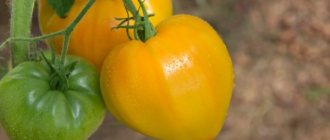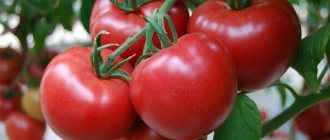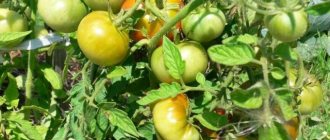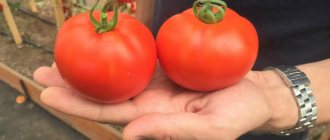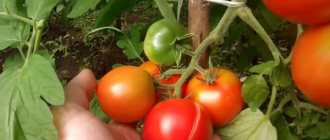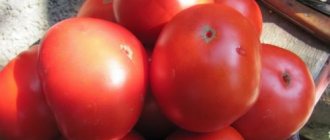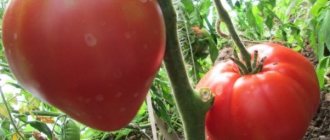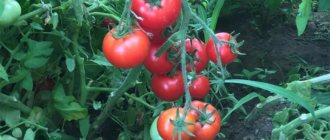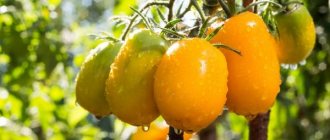Description of the variety
Let's start the description of a high-yielding, mid-early variety with the characteristics of the bush:
- determinate type, standard variety;
- height from 50 to 60 cm;
- the number of leaves is average;
- leaf color is light green;
- leaf size is medium.
Despite their small size, it is recommended to fix the bushes on a support.
The optimal option is 1 branch - 1 support. The hand load on each branch is large (up to 5 hands), the support will not allow the fruits to lie on the ground. Clean fruits mean a high-quality harvest. Many summer residents value the Russian Bells tomato for its high decorativeness and productivity; they are planted in flowerpots and used to decorate the garden and patios. The plants are especially beautiful when the fruits ripen. Characteristics of tomatoes:
- fruit color is pink-scarlet;
- fruit shape is pear-shaped;
- fruit size is small;
- fruit weight up to 60 g.
Varietal tomatoes are always valued for their good taste, Bells of Russia is no exception. The pink pulp contains a high concentration of elements useful to the human body: sugars, amino acids, vitamins. The taste of tomatoes is characterized by a perfectly combined sweet and sour notes. The undoubted advantage of the fruit is its resistance to cracking and universal purpose.
Bells of Russia - variety of Tomato plant
Variety characteristics:
Properties of the variety Bells of Russia:
Recommended region on the map:
Information on the admission of Tomato Bells of Russia from the Register of the State Variety Commission of the Russian Federation
Application for admission No. 33282, registered 1999-10-21. The Tomato variety Kolokola Rossii was included in the register of those approved in 2000. Approved for use in regions: All regions.
The originators of the Tomato Kolokola Russia variety are:
Other varieties of tomato plant
Search for variety by name
Variety selection
Question to the portal experts
If you haven't found the answer to a question, don't hesitate to ask an expert.
Register or Login so you don't have to enter your Name and Email every time
Thanks for the comment! It will be published after checking by a moderator!
No comments yet, be the first!
A portal for those who love their dacha
Your question has been sent for moderation. Don't worry, we quickly check your questions and your question will be answered within 1 day.
We have noticed that you are already registered on our website. We recommend that you log in to view the question you created. If you don't remember your password, you can recover it.
You were not registered until today, so we have registered you. Your password has been sent to your specified mailbox.
Help our site develop!
Please read this message, it will not take up much of your time!
We so need your comments and questions to understand in which direction we should develop.
Don't forget to leave a comment if you found what you were looking for. And if you haven’t found it, use the “Ask an Expert” form in the site header. We will answer this question, and other visitors will be able to find the information that you could not find.
History of origin and directions of use
The selection of tomatoes is Russian, there is no data on the variety in the state register, however, the variety is grown in all regions of the Russian Federation , excluding the Far North. In areas with a mild climate, tomatoes grow well in open ground; in northern areas they develop better in protected ground. Polycarbonate greenhouses and small arc tunnels are suitable for tomatoes.
See also
Description of the tomato variety Boy with a Thumb, features of cultivation and careRead
Let us highlight the main areas of fruit use:
- consumption of fresh tomatoes without heat treatment: salads, decoration for banquet (buffet) tables;
- production of whole-fruit canned tomatoes;
- preparing traditional salted tomatoes according to old Russian recipes.
There are positive reviews online about pear-shaped tomatoes Kolokola Rossii, golden yellow in color. Early fruit ripening (100-110 days), high commercial and taste qualities of the grown fruits make the variety competitive in the seed market.
Table of the main advantages and disadvantages of Kolokol Rossii tomatoes:
| Advantages | Flaws |
| unusual fruit shape | Tomatoes need fertilizers for full development |
| possibility of universal use of fruits from salads to canned vegetables | you need to monitor the shape of the bush, remove excess stepsons |
| easy care | |
| preservation of flowers and ovaries during short-term temperature fluctuations | |
| stable immunity to diseases of nightshade crops |
Features of cultivation
Seeds are sown for seedlings in the second half of March. When subsequently transplanting into a greenhouse, you can sow them earlier. The soil is preferably light, consisting of turf soil, humus and sand. The seeds are pre-soaked in a growth stimulator or freshly squeezed aloe juice, and then sown at a depth of 2 cm. The top of the container is covered with film and placed in a warm place. After the sprouts appear, the container is exposed to bright light.
In the phase of appearance of 2-3 true leaves, the seedlings are picked and fed with a complete complex fertilizer . Watering is moderate, only warm, settled water is used. Grown seedlings need to be hardened by taking them out into the open air, first for half an hour, and then leaving them outside for the whole day.
Planting in a greenhouse is possible in early May, in open ground - in late May-early June. Before planting, the soil is loosened and a small amount of complex fertilizers or wood ash is placed in the holes. The optimal planting scheme is 3 plants per 1 square. m. Thickening of plantings can cause diseases and reduce fruiting. Tomatoes like not too frequent, but abundant watering with warm water. Feeding is required with alternating mineral and organic fertilizers.
Of the minerals, preference is given to complexes with a high content of phosphorus and potassium; excess nitrogen causes the ovaries to shed. From organic matter, diluted mullein or bird droppings are suitable. Grown bushes are formed by removing part of the lateral shoots and lower leaves. It is better to tie branches with fruits to a support.
Sow the seeds correctly
It is important to choose the right time for planting seeds. For open ground - this is the second half of March, for a greenhouse - from late April to mid-March. Conduct:
- mandatory seed rejection procedure (visual control);
- identifying hollow seeds by soaking in slightly salted water (remove floating ones);
- carry out the prevention of tomato diseases - keep for 15 minutes in a solution of potassium permanganate.
See also
Characteristics and description of the tomato variety Golden Domes, its yieldRead
The first stage of growing tomato seedlings from seeds lasts from sowing to picking. At this time, we use low containers (preferably made of plastic). We use high-quality soil for germinating seeds, purchased, or prepare our own, mixing garden soil, compost, and peat in a 2:1:1 ratio.
Sowing seeds is easy:
- moisten the soil well an hour or two before sowing the seeds;
- spread the seeds thinly over the surface;
- cover the seeds with humus or soil mixture;
- Cover the container with the seeds with film and place it away from a cold window.
The second stage lasts from picking the seedlings to planting them in the ground. During this period, for seedlings, prepare separate cups or rectangular plastic containers for seedlings, with sides at least 25 cm high. Dive (transplant) tomato seedlings in the 1-2 leaf phase into these containers.
Pests and diseases: control and prevention measures
The variety is quite resistant to diseases. For prevention, you need to promptly remove weeds and mulch the soil with straw or peat. Spraying with a pink solution of potassium permanganate helps against gray rot; copper-containing preparations will prevent late blight. Frequent spraying with phytosporin also gives good results.
You can destroy insects using insecticides or proven folk recipes. Soapy water helps fight aphids; naked slugs and Colorado potato beetles are destroyed by an aqueous solution of ammonia.
See also what chemicals can be used to combat the Colorado potato beetle: Aktara, Corado, Regent, Commander, Prestige, Lightning, Tanrek, Apache, Taboo.
Bells of Russia is a promising variety for open ground, greenhouses or flowerpots. The plants are suitable for experienced or novice gardeners; they do not require excessive care, providing a stable harvest.
Caring for seedlings, transplanting into the ground
For about another month, after a successful picking, the tomato seedlings are kept in a warm room. Activities for caring for tomatoes during this period:
- watering the tomato at the root when the top layer of soil dries out;
- 1-2 root feedings with any liquid fertilizer for tomatoes, you can simply infuse banana peels and pour this “compote” over small tomatoes;
- a weekly procedure for hardening tomatoes with a decrease in night temperatures to 8 ° C.
We plant adult tomato seedlings (50-60 days from germination) in a permanent place. We place no more than 3 tomato bushes in a square place. This is a recommendation from the seed manufacturer and should be followed.
Agrotechnics of cultivation, planting and care
Sowing the seeds of this variety of tomatoes for seedlings is carried out 55-60 days before the intended planting in the ground. Picking seedlings at the stage of two true leaves. When planting seedlings in a permanent place per 1 sq. Up to 6 plants are placed per meter of plot. Watering and fertilizing are carried out as needed.
If you grew Kolokola Rossii tomatoes, please write whether you liked them or not. What was the yield and taste of the fruits like under your climatic conditions? How do you assess a variety's resistance to disease? Briefly describe the advantages and disadvantages of this tomato in your opinion. If possible, attach to the comment a photo of the entire bush as a whole or individual fruits that you grew. Thank you!
Your reviews of the Kolokola Rossii tomato and additions to the description will help many gardeners evaluate this variety objectively and decide whether it is worth planting or not.
Care
After planting seedlings in the ground, it is important to carefully tie the plants to a support, regularly water and weed them. At the beginning of the growing season, it is advisable to feed the plants with nitrogen.
In the future, to improve taste and strengthen the root system, it is recommended to add phosphorus and potassium. Mineral fertilizers can be replaced with wood ash if the gardener wishes. It can be added to water when watering or directly to the ground.
Landing
Seeds are sown from the 2nd-3rd decade of March. They use a loose nutrient substrate, which is prepared from such components
- like peat;
- sand;
- compost;
- vermiculite;
- and humus.
Seeds are placed in the grooves to a depth of 2 cm and at a distance of 3 cm. Sprinkle a thin layer on top.
What are the rules of care:
- irrigation through a sprayer or spray bottle;
- fertilizing 2 times (Kemira, Krepysh, nitroammofoska);
- diving when 2 leaves grow;
- hardening at 15 degrees for 7-10 days.
Aftercare
Tomatoes need to be watered promptly
The variety's agricultural technology includes a standard list of necessary procedures that do not cause difficulties for young gardeners.
Care measures include proper watering and timely fertilizing, which affect the health and fruiting of the bushes.
Secondary procedures include the formation of a bush, which is carried out at will, weeding, loosening and tying.
The bush is classified as a determinate type, so it is able to withstand weight, but after the ovaries form, it is recommended to tie it up so that the shoots do not break under their weight.
Watering
The main condition for growing a crop is proper watering.
- Seedlings are moistened during planting in open ground, and then after 8-10 days. During the acclimatization period, excessive waterlogging will weaken the plant’s immunity.
- Before the first ovaries form, water once every 7 days, adding at least 4 liters of water per bush.
- During the period of active fruiting, the procedure is carried out 2 times a week, but the volume of liquid per bush is reduced to 3 liters.
If tomatoes are planted in a greenhouse, it needs to be ventilated, because... High humidity causes fungal diseases.
Water the plants in the evening to prevent sunburn. The next morning, the ground is loosened to prevent the formation of a crust. The procedure improves air circulation to the root system and prevents it from rotting.
Weeding is combined with loosening, which prevents the appearance of pests (for example, slugs).
Top dressing
Tomato productivity directly depends on timely application of fertilizers. Plants that form large fruits expend energy faster, so several procedures are carried out during the season.
The feeding schedule includes 3 stages.
- 2 weeks after planting in open ground, add a solution of mullein, which is diluted in a ratio of 1:15.
- The procedure is repeated after 14 days. Tomatoes are supported with superphosphate and potassium (25-30 g of product per 10 liters of water).
- The last fertilizing is carried out during the period of active fruiting to maintain plant health. Add potassium humate (1 tbsp per 10 liters of water).
Bush formation
Abundant and stable fruiting is observed in plants formed into 1-2 stems.
The characteristics of the variety include the removal of lateral shoots, except for one shoot, which serves as an additional stem. The first pinching is carried out when transplanting into open ground.
The procedure is repeated weekly and the shoots formed from the leaf sinus are eliminated. There is no need to completely remove side shoots from a young plant (leave 3 cm) so as not to injure it.
Protection from pests and diseases
The variety is resistant to most diseases that affect nightshade crops. The possibility of fungal infection occurs when growing techniques are not followed.
For prevention, plantations are treated with special means.
- Fitosporin. The natural components that make up the drug make it safe for plants and humans, so it is used even during the period of active fruiting. The solution (200 g of powder per 400 ml of water) is treated no more than 4 times per season.
- Quadris. The product is suitable for the prevention or treatment of primary signs of the disease. In the later stages, the effect will be minimal. Solution recipe: 5 ml of the drug per 10 liters of water. They do everything gradually. Initially, 100 ml of liquid is taken into the sprayer tank, fungicide is added and mixed. Then the remaining amount of water is added and the plantation is processed.
Tomato bushes attract the attention of aphids, caterpillars, whiteflies, and wireworms. To prevent their occurrence, mulching the ground with humus or peat, spraying with a soap solution (250 g of grated soap per 10 liters of water), and you can also sprinkle the ground with black pepper and ash
tomato Tsar Bell. Variety seeds SIBERIAN GARDEN. height 80-100 cm. weight up to 700 g
Common tomato Tsar Bell. Brief overview, description of characteristics, where to buy seeds
Promising varieties of tomatoes in Siberia. Introducing vegetables of Siberian selection: Tomatoes Batyanya and Knyaginya
Tomato Snow Leopard: description, photos, reviews
The Snow Leopard tomato is a relatively new variety that has quickly gained wide popularity among gardeners in the middle zone and colder regions of the country. The taste and quality of the fruit, high resistance to temperature changes, good yield and many other advantages have made this tomato a favorite of many gardeners.
Description of the tomato variety Snow Leopard
This tomato variety, bred in Russia in 2008, is considered mid-early. Snow Leopard tomato bushes are determinate; in open ground they do not grow higher than 60 cm.
When planted in a greenhouse and film shelters, this figure is slightly higher - 80-90 cm. The compactness of the bushes allows you to use more dense planting and save space on the site.
The tomato foliage is high, the foliage is large, dark green.
Description of fruits
Ripe tomatoes of the Snow Leopard variety are distinguished by their bright, richly colored skin, which has sufficient density to protect the fruit from cracking. The shape of the tomato is flattened, spherical, with slight ribbing at the top.
The average weight of one tomato is in the range of 120-150 g, but individual specimens weighing up to 300 g ripen. The bright red flesh has a rich taste with a subtle sourness. It contains an increased content of sugars and amino acids.
The pulp is juicy, fleshy, contains a small number of seeds.
The commercial characteristics of tomato are valued among gardeners who grow for sale: keeping quality and transportability are very high. The fruits do not lose their taste and attractive appearance for a long time.
Characteristics of the variety
A detailed description of the characteristics of Snow Leopard tomatoes gives a complete picture of this variety. The characteristics of the tomato are presented in the assessment of all important varietal indicators.
Productivity and fruiting
The productivity of the Snow Leopard variety is quite high, given the compactness and small size of the plants themselves. The yield indicator may vary when grown in a greenhouse and open ground.
In the latter case, it averages 2-3 kg/bush; in a greenhouse, 4-5 kg of sweet tomatoes are harvested from one bush.
Since 4 to 6 plants can be placed per 1 m2, the yield of the variety ranges from 8-30 kg/m2.
The yield of the variety is influenced by the quality of care for the bushes. And although these tomatoes are considered one of the most unpretentious, timely shaping, in special cases they need garter and watering.
Depending on planting conditions, Snow Leopard fruiting occurs 95-110 days after emergence. Tomatoes are formed on fruit clusters of 4-6 pieces.
Area of application of fruits
Grown tomatoes of the Snow Leopard variety will be an excellent ingredient in summer salads, as well as in winter preparations. Everything that cannot be eaten fresh can be processed - delicious juice, ketchup, pickles and marinades are obtained from these tomatoes.
Resistance to diseases and pests
The Snow Leopard variety is characterized by high resistance to many common tomato diseases caused by fungi. The risk of Fusarium or Verticillium wilt is low, which is good news for gardeners. The Snow Leopard also shows good resistance to crop pests.
Advantages and disadvantages of the variety
The relatively young tomato variety Snow Leopard quickly gained great popularity among Russian gardeners. The reason for this phenomenon is a whole range of advantages of the variety that gardeners liked so much:
- taste and commercial qualities of fruits;
- possibility of growing both in protected and open ground;
- high resistance to temperature changes and rapid adaptation to any conditions, which allow growing tomatoes in cold regions of the country;
- versatility of fruit use;
- resistance to diseases and pests;
- unpretentiousness in care, which allows summer residents who do not have the opportunity to be present in the garden every day to get a good harvest of tomatoes;
- absence of cracks on fruits during ripening, as well as during whole-fruit canning.
The only drawback of the Snow Leopard is the need to form bushes and garter the stems.
Growing rules
Growing Snow Leopard tomatoes has several features. They must be taken into account in order to get a high yield.
Planting seedlings
Sowing tomato seeds for seedlings begins in March and follows standard technology:
- Planting material is sown in pre-prepared loose and fertile soil, deepening it to 1-2 cm. Before planting, the substrate is moistened.
- Each container is covered with film to maintain humidity, put in a dark, warm place and wait for germination.
- As soon as the first shoots appear, the containers are placed on a well-lit windowsill.
- It is recommended to pick Snow Leopard sprouts at the stage of appearance of the first true leaves.
- Each sprout is carefully dug out from the total mass and transplanted into a separate container. If the seedlings have stretched out due to lack of sunlight, they are buried during transplantation. The thin stem does not rot in the soil, but develops adventitious roots.
- 10 days after picking, feed the seedlings with water-soluble complex mineral fertilizer.
- Care before planting in a permanent place comes down to moistening the soil, fertilizing and hardening.
You can learn more about sowing seeds for seedlings from the video:
Transfer
The timing of transplanting tomatoes to a permanent place falls on:
- early May for unheated greenhouses and greenhouses;
- the second half of April, if protective structures are heated;
- end of May when planting in open ground.
More precise timing for planting seedlings depends on the climate of the region and the recommendations of the Lunar calendar. By this time, the seedlings should have at least 6 leaves, a strong stem, the height of which is about 30 cm. The optimal age is 45-50 days.
There are several standard rules for transplanting tomatoes to a permanent location:
- In accordance with the planting scheme, small holes are dug in pre-prepared beds.
- Each seedling is placed in a hole at an angle of 450, sprinkled with soil and compacted.
- Watering is carried out, spending about 1 liter of water for each specimen.
Important! After watering, it is recommended to mulch the soil under the Snow Leopard bushes.
Since plants of this variety are very compact, choose a planting scheme that will save space on the site. Seedlings can be arranged in a strip-parallel pattern, maintaining a distance between adjacent seedlings of 25 cm and a width between rows of 60 cm. The most common planting option is a checkerboard pattern, in which all plants are well illuminated and care operations are simplified.
Aftercare
When growing a Snow Leopard tomato, they devote time to standard care operations: regular, but not excessive, watering, weeding, loosening the soil under the bushes. But obligatory operations are gartering and shaping the plants.
Since the yield of the variety is high, it is recommended to tie up the plants. This allows you to avoid breaking the stems under the weight of your own fruit. In greenhouse conditions, the tomato is tied to a trellis stretched at the top of the structure. In open ground, individual support stakes are usually organized, to which plant stems are tied.
The formation of bushes begins at the stage when they produce a strong stepson under the first flower cluster. It can be left to form a 2-stem tomato. This method is usually used when growing in a greenhouse or film shelter. In order to grow only 1 stem, all competing stepsons are promptly removed.
Important! To achieve good fruiting of the Snow Leopard, pinching is carried out regularly (the fattening shoots are removed when they reach a length of no more than 5 cm), and as the bushes grow, the lower leaves are removed.
Feeding bushes should be done with extreme caution. Snow leopards growing in well-fertilized soil tend to develop green mass.
Therefore, with intensive feeding, the bushes actively grow lush, beautiful greenery to the detriment of yield - very few fruits are formed on such plants.
Pest and disease control
Although the Snow Leopard is famous for its good resistance to pests and diseases, preventive measures will not hurt. These include:
- treating the soil before planting seedlings with a solution of potassium permanganate or fungicide;
- pre-sowing heating of seeds at a temperature of 500C;
- timely watering and its norms;
- removing weeds and plant debris from the tomato bed.
All these manipulations do not take much time, but they allow you to avoid possible problems associated with the activity of insect pests and pathogens of crop diseases.
Conclusion
The Snow Leopard tomato is easy to care for, easy to grow and has reliable yields even in the worst gardening seasons. Even a novice gardener can grow these tomatoes and reap a good harvest. The main thing is to take into account some of the features of planting and care, and if everything is done correctly, the bushes will be strewn with glossy, delicious tomatoes.
Reviews
Gardeners who grow certain varieties of tomatoes on their plots love to share their results, so they leave reviews on the Internet. They are also actively discussing Snow Leopard tomatoes.
Olenev Boris Olegovich, 60 years old, Chelyabinsk I love tomatoes grown in open ground; in my opinion, their taste is more pronounced than those grown in greenhouses. But in the Southern Urals it is difficult to choose a variety that will bear fruit normally - the summer is short, cold, the tomatoes have to be picked while still green and left to ripen at home in a box. Last season I grew Snow Leopard tomato seedlings, planted them, and the result exceeded all my expectations! I picked 2.5 kg of excellent tasting tomatoes from one bush. There was no damage such as cracks on any of them. Now I will always set aside a small bed for them and try new varieties. Marina Ivanovna Zakharenko, 36 years old, Kurgan I learned about this variety from the Internet. Before deciding to plant a Snow Leopard tomato, I read the reviews and characteristics (for me, yield is important, first of all), and looked at photos of tomatoes. In general, the varietal descriptions of tomatoes inspired me, I grew seedlings and planted them in a greenhouse. My expectations were justified - I was very pleased with the harvest; I collected 4.7 kg of tomatoes from one bush. I didn’t notice any traces of disease, the bushes looked healthy, the tomatoes themselves were evenly colored, without spots. It’s a pity that I just didn’t dare to plant more roots, but next year I’ll set aside 2 greenhouse beds for them.
Source: https://agrognom.ru/vegetables/tomatoes/tomat-snezhnyj-bars-harakteristika-i-opisanie-sorta.html
Tomatoes: advantages and disadvantages
Vegetable growers note the following advantages of the Kolokola Rossii variety:
- Unusual fruit shape;
- Excellent taste and aroma;
- Versatility in the use of tomatoes;
- Plants do not require special care;
- Tomatoes tolerate minor temperature changes well;
- Strong immunity to most dangerous diseases.
Tomato Bells of Russia (gold):
Tomatoes also have some disadvantages:
- Bushes are demanding on the composition of the soil;
- Plants need pinching.
Useful video
| Super early | Mid-season | Mid-early |
| White filling | Black Moor | Khlynovsky F1 |
| Moscow stars | Tsar Peter | One hundred poods |
| Room surprise | Alpatieva 905 a | Orange Giant |
| Aurora F1 | Favorite F1 | Sugar Giant |
| Severenok F1 | La La Fa F1 | Rosaliza F1 |
| Katyusha | Right size | Em Champion |
| Labrador | Dimensionless | Sultan F1 |
If you find an error, please highlight a piece of text and press Ctrl Enter.
